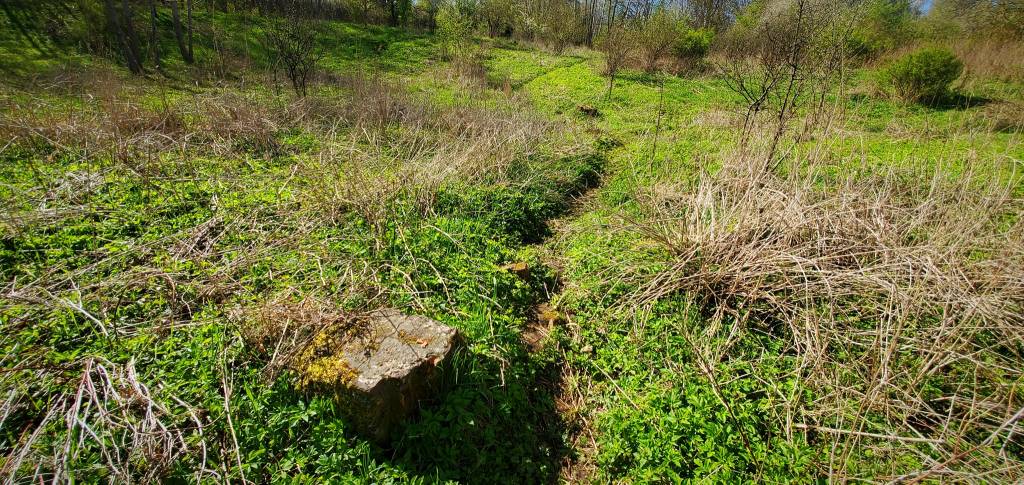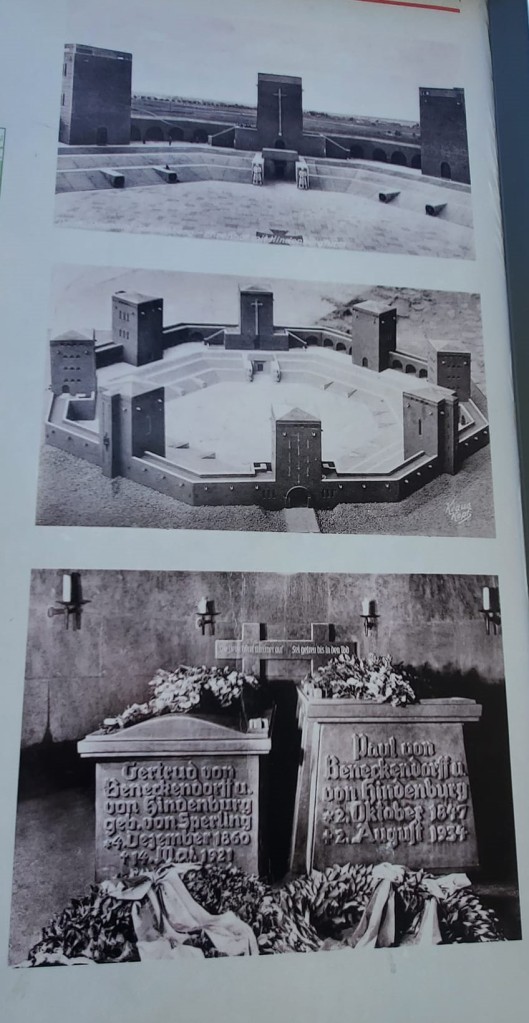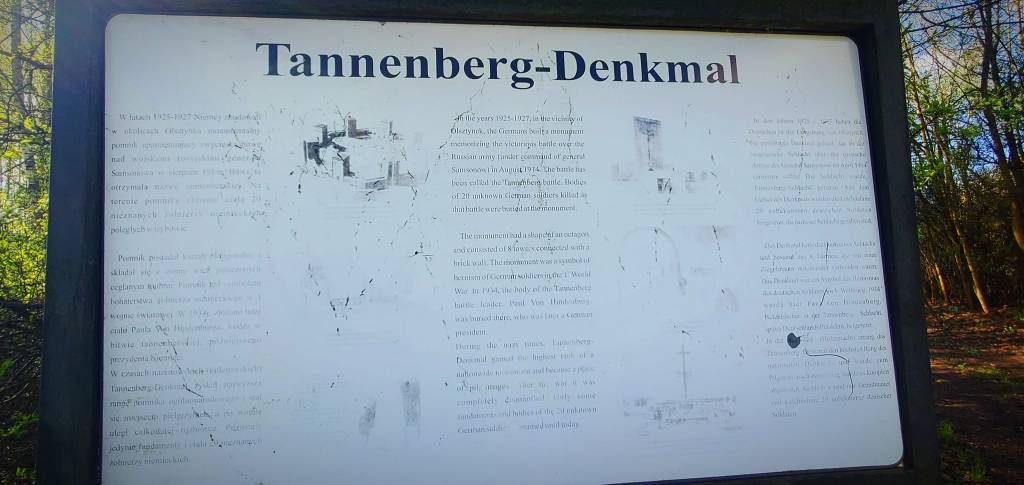The entire history of the German experience between 1914 – 1945 is symbolized by an empty field in northern Poland. This was where the Tannenberg Memorial stood for almost twenty years. The Memorial was the spiritual home of interwar German militarism in East Prussia, a German province seething with reactionary revanchism. The memorial commemorated the German victory at the Battle of Tannenberg in the opening weeks of World War One. The Germans went on to lose the war and famously lost postwar peace. The Tannenberg Memorial was a response to those losses. It proclaimed victory in defeat. The memorial was the scene of huge nationalistic and Nazi-inspired rallies. It provided the Germans with a rallying point during the interwar period. One that goaded them on to the next war and where they suffered total defeat. The Tannenberg Memorial did not last either. It suffered partial demolition and looting until there was barely anything left except an empty field.

Piece of history – Remnant of the Tannenberg Memorial
Surreal Experience – Interest & Indifference
A couple of days before visiting where the Tannenberg Memorial once stood, my travel companion and I went to the ruined Wolf’s Lair (Wolfsschanze), Adolf Hitler’s military headquarters for the Eastern Front in the Masurian Lakes region of northeastern Poland. I expected the site to seem sinister and creepy. Instead, it felt overwrought and useless. To me, the Wolf’s Lair was little more than a novelty. Worth seeing, but of no lasting value. Everything that happened there was without success. From defeat on the Eastern Front, to the botched assassination attempt on Hitler’s life by Claus von Stauffenberg. The Wolf’s Lair was ultimately a monument to failure. One large ruin after another, devoid of any redeeming value other than as curious relics of a regime in catastrophic decline. My interest soon turned to indifference.
I had the opposite experience picking through the scant remains of the Tannenberg Memorial. A walk around the site was a surreal experience. Weeds, tufts of grass, and unsightly brush were conspicuous. By the standards of landscapes, the setting was intensely mediocre. It was hard to imagine that tens of thousands of people once stood in this same space for the dedication of the Memorial in 1927. Or that Hitler and his henchmen held some of their most sinister ceremonies on this ground. I could not even imagine bird watching here, let alone a torch light procession. To be quite honest, it was hard to imagine anything of note had ever happened on such an average piece of property. This sacred ground for the Nazis was now shrouded in obscurity.

In the trenches – Tannenberg Memorial
Open Wounds – Grounds For Dismissal
Time had not been good to the Tannenberg Memorial’s remains. While some like to say that time heals all wounds, in the memorial’s case, time had only covered most of the wounds in moss and weeds. A closer inspection showed that the ground here had yet to heal from the monumental monstrosity which once covered it. In several places, the remnants of brick work were randomly scattered across the ground. Every so often something crunched beneath my feet. This signaled that I was standing on small pieces of the monument. Some of the pieces were easily visible. Stooping down, I would see a bit of brick that had once been part of a much larger structure. Trying to make sense of what part of the former memorial my friend and I were standing on was impossible. We did not have a map of the memorial’s layout. This oversight did have a good side effect, we were forced to use our imagination.
More and more pieces of the Memorial began to materialize the further we walked into the site. On one end of the property. I discovered what appeared to be a ditch. I soon plunged several meters into an overgrown trench. My friend soon joined me. We found pieces of brick strewn across the bottom and a larger portion on one side. Some of these pieces were still embedded in the ground. The ditch may have been part of the original structure, or it might have been part of earthworks that were sculpted around the memorial. The architects wanted to create a perception of the Memorial as an impregnable fortress. One that would honor some unknown German soldiers who had fallen in the Battle of Tannenberg. Later, Paul von Hindenburg, the commanding general at Tannenberg would be deified at the Memorial, when Hitler decided to have his body buried here.
The Memorial’s aesthetics were militaristic in the extreme. It was difficult to imagine that at one time there had been eight 20-meter-high towers as part of an octagonal shaped structure. The Memorial was designed to look like a medieval castle used by the Teutonic Knights. My travel companion and I had already visited Malbork Castle, which was once the magnificent headquarters of the Teutonic Knights. It also happens to be the largest castle in the world measured by land area. The Tannenberg Memorial attempted to mimic a semblance of its style and size. While Malbork Castle has survived, the Memorial has not. This was not for want of trying. The Memorial was built to last. Ironically, the Germans would be the ones initially responsible for demolishing parts of it. They could not even succeed at that task. With the Red Army closing in, they fled the area. It would take several generations for the Poles to pick the Memorial apart.

Standing its ground – Remnant of the Tannenberg Memorial
Faith & Fear – A National Shrine
My travel companion soon was urging me to see a different part of the property. That was where he found the most prominent remnant of the Memorial. A hip high square of brick stood by itself. I found the use of brick fascinating. An overwhelming majority of the historic churches in northern Poland are built out of brick. In my opinion, this was not just a case of the Germans using local materials for the Memorial. Whether purposely or subconsciously, much of the structure was built out of brick. The Tannenberg Memorial was in harmony with other sacred structures throughout the region. The Memorial was considered a national shrine, a quasi-religious site for Germany’s uber-nationalists and Nazis. Thankfully, the Memorial has now all but vanished. Nonetheless, there was just enough of it remaining to understand what once stood here and what it stood for. That made the site worth visiting, but only once. That would be enough.
Click here for: Riding The Tannenberg Cycle – August 1914, 1933, 1934 & 1939 (Northern Poland & Berlin #35)



